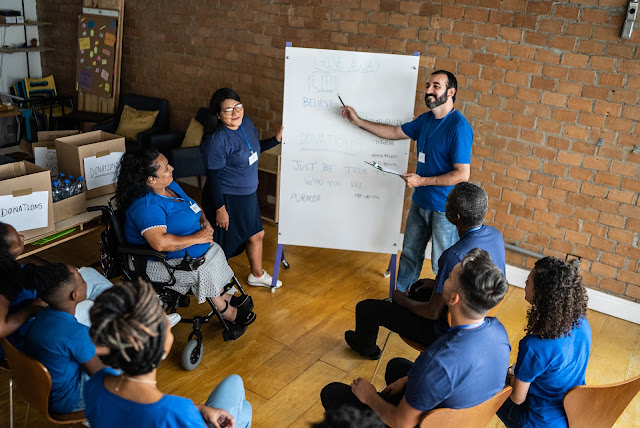By Kim Gannon and Emily Pasman, guest authors
Twelve Step programs are ubiquitous in the US substance use
disorder (SUD) treatment landscape. For many, they provide a powerful forum of
life transformation, fulfillment, and purpose. We are two such people: two
statistically rare cases (Dodes & Dodes, 2015) who have successfully found
long-term recovery from SUD via Twelve Step participation. While we have
benefitted personally from these programs, we cannot ignore the lives they put
in jeopardy by stigmatizing people who use medications for opioid use disorder
(MOUD) and harm reduction strategies. Without large-scale structural and
cultural change, Twelve Step communities will continue to harm those they
intend to help.
To bring awareness to this tension, we recently authored a commentary entitled Knowing or not knowing: Living as harm reductionists in Twelve Step recovery in the Journal of Substance Use and Addiction Treatment. In it, we begin by describing our journey from drug use to Twelve Step meetings, often called “the rooms” by attendees. Then, we outline our path to embracing harm reduction and non-abstinence recovery pathways. Some of what brought us to harm reduction was academic; we immersed ourselves during graduate school in the overwhelming literature supporting harm reduction over abstinence-only modalities (Barnett et al., 2020; Paquette et al., 2022; Wakeman et al., 2020). Some, however, was much more personal: dozens of our friends and community members have died of overdose in the past few years alone. Beyond grief, rage, and gratitude for our own lives, these experiences have provoked deep reflection and interrogation of our own biases and those of the communities we are a part of.
Editor's note: The authors of this guest post were interviewed by our colleagues at the Peer Recovery Center of Excellence for the April 2023 episode of the "Recovery Talk" podcast. We invite you to listen to that conversation here.
As graduate students in public health and social work, we frequently find ourselves in dialogue about power and privilege. When wrestling with the way institutions exert influence, we are presented with a common question: “Who’s in the room?” Who are the voices that are heard, privileged, and acted upon in decision-making circles? Historically, the answer is us. Even in 2023, abstinence is still perceived as the “right” (or only) way to recover from SUD, and those who can attain it are elevated in social, clinical, and political circles. We wrote this piece, however, to bring attention to those who are not “in the room(s)”: those kept out due to stigma, and those who died from gatekeeping in the very communities that saved our lives.
To be part of the solution, we offer several suggestions.
Individual Twelve Step members can work to deconstruct their own biases and to
vocalize their support for non-abstinence pathways in meetings, including by
directing people who use MOUD and harm reduction to supportive people and
groups. At the meeting level, groups can adopt policies that proactively state
support for other pathways in a reading at the beginning of meetings, similar
to the Alcoholics Anonymous “safety card” (Alcoholics Anonymous, 2022).
Moreover, clinicians can clearly communicate the risks and benefits of Twelve
Step participation to their clients, as well as offer themselves as a resource
to help navigate messages from “the rooms” that may not support clients’ goals.
However, without policy change – including removal of meeting attendance
requirements from criminal-legal and treatment settings, changes to Twelve Step
literature, and oversight to hold groups accountable for harmful messages they
spread – these changes will not suffice.
Harm reduction philosophy promotes the inherent worth and
dignity of the individual, regardless of their drug use. Twelve Step philosophy
aims to be of maximum service to others, particularly those suffering from SUD.
These philosophies are more than compatible, and combined they can be
unstoppable. But we cannot achieve this unity without a major reckoning within
Twelve Step communities. And as people lucky enough to be “in the room(s),” we
must dedicate our lives to making it happen.
References
Alcoholics Anonymous. (2022). Safety card
for A. A. groups. https://www.aa.org/safety-card-aa-groups.
Barnett, M. L., Barry, C., Beetham, T.,
Carnevale, J. T., Feinstein, E., Frank, R. G., de la Gueronniere, G., Haffajee,
R. L., Kennedy-Hendricks, A., Humphreys, K., Magan, G., McLellan, A. T.,
Mitchell, M. M., Oster, R., Patrick, S. W., Richter, L., Samuels, P. N.,
Sherry, T. B., Stein, B. D., … Vuolo, L. (2020). Evidence based strategies
for abatement of harms from the opioid epidemic. Washington, DC: Legal
Action Center.
Dodes, L., & Dodes, Z.
(2015). The sober truth: Debunking the bad science behind 12-step programs
and the rehab industry. Beacon Press.
Paquette, C. E., Daughters, S. B., &
Witkiewitz, K. (2022). Expanding the continuum of substance use disorder
treatment: Nonabstinence approaches. Clinical Psychology Review, 91,
102110. https://doi.org/10.1016/j.cpr.2021.102110
Wakeman, S. E., Larochelle, M. R., Ameli,
O., Chaisson, C. E., McPheeters, J. T., Crown, W. H., Azocar, F., &
Sanghavi, D. M. (2020). Comparative effectiveness of different treatment
pathways for opioid use disorder. JAMA Network Open, 3(2),
e1920622. https://doi.org/10.1001/jamanetworkopen.2019.20622





.jpg)